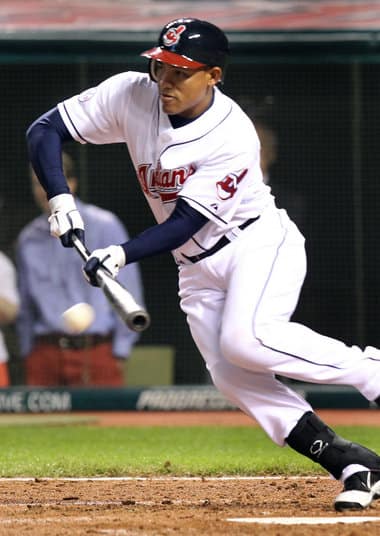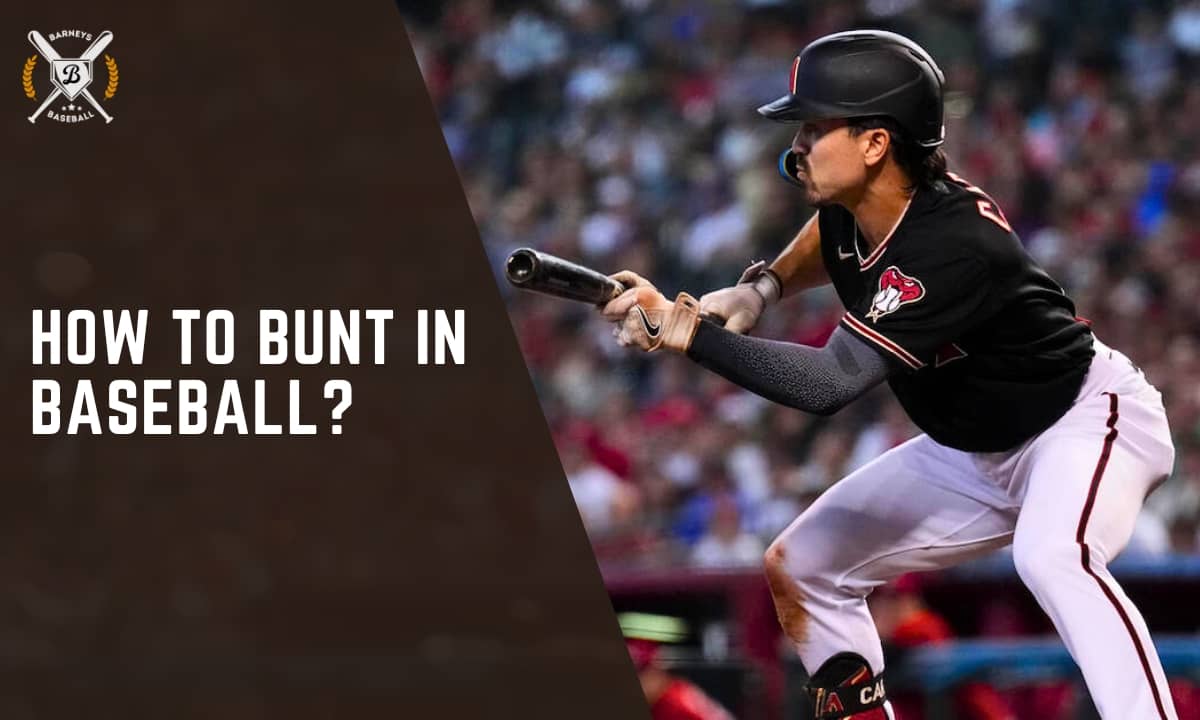How to bunt in baseball like a pro is shown here.A runner can make remarkable progress using bunting. If you have enough speed, you can even bunt to score a hit! Bunting does, however, need some talent, particularly because it differs so significantly from your typical bat swing. Fortunately, with a little experience and attention to detail, it’s not too difficult. We’ll cover all you need to know in this article.

1. Head Position
In order to view the baseball and the baseball bat in your field of vision, you should position your head behind the barrel. Although a little nerve-racking at first, this is a crucial component of bunting. Naturally, you’ll want to keep an eye on the ball until it strikes the barrel.
2. Show a bunt if needed
Put yourself in the stance right away if you’re bunting to move runners. Entering the batter’s box and adopting a bunting stance with both hands on the bat is known as “showing bun.” If you’re a pitcher, for instance, you show bunt when everyone knows you’re going to bunt. If you want to put down a surprise bunt, you might not want to show bunt.
- The opposing team’s first and third basemen should advance to the batter’s box to field the bunt as soon as you demonstrate it. Bunt until the pitcher begins his motion; this can help you surprise them and boost your chances of laying down a good bunt.
3. Lower the bat and move your feet
Put yourself in the bunting posture as soon as the pitcher stretches. Maintain the same position for your bottom hand as you always do. Slide your upper hand slowly into the barrel where the bat starts to get thicker. The bat barrel ought to be slightly angled upward, between a 30° and 45° angle with respect to the ground. At all times, the barrel should be above the hands.
- Make sure to maintain your thumb and index finger firmly behind the barrel of the bat if you decide to grasp onto it. The front of the bat, which is the portion next to the pitcher, should not be obstructed by overzealous fingers, nor should any fingers protrude.
4. Ready yourself for a pitch
As you square up to bunt, turn your back foot in the direction of the pitcher. If you happen to lay down the bunt, you won’t be able to explode out of the batter’s box since both feet should not create a straight line with the plate. Rather, square off your upper body toward the pitch and turn your rear foot in the direction of the pitcher.You can swiftly turn your body back to avoid getting struck if the pitch comes inside.
5. Pull back on ball
Search the strike zone for bunts unless it’s a suicidal squeeze. If this is not a strike pitch, pull back with the bat. You want to bunt whatever pitch you can make contact with when facing a suicide squeeze. If not, you should only bunt strikes. Pull the bat back to signal to the umpire that you’re taking the ball and not trying to bunt whether the pitch is down low, up high, or way outside or inside. Simply keeping your bat over the plate will probably result in a strike call from the umpire.
6. Angle your bat
To position the bunt, turn the barrel in that way. Whether or not you beat out the throw depends greatly on where you put your bunt. Angle your bat such that it squares up with the third baseman if you want to bunt on the third base side. Angle your bat so that it squares up with the first baseman if you want to bunt on the first base side.
- Before you enter the batter’s box, survey the infield. You should generally aim your bunt as close to the third baseline as you can if, for example, the third baseman is shaded closer to the shortstop than he should be or is playing close to the grass.
- There’s no agreement on the ideal location for your bunt. Some claim that it’s best to bunt the ball between the pitcher and the third baseman since they could not be sure who would field it. Some believe that bunting in the direction of the second baseman requires him to make a very difficult throw across his body.
- Consider bunting in the direction of the second baseman if there is a runner on first base. Try to bunt between the shortstop and third baseman if there is a runner on second base.
Related: Yankee Stadium Bag Policy
7. Lean down and spread your feet
It’s difficult to make contact if you drop your bat without bending. It’s quite challenging to drop your bat to bunt a low pitch and demands extraordinary hand-eye coordination. Anyone can bend their knees because it’s a really simple movement.
8. Keep an eye on the pitch to build interaction
As the ball enters the plate, keep your eyes on it. Look the ball into the bat as the pitch approaches. You want to keep your gaze as much on the ball as you can.
9. As you hit the ball, step back from it
Just before the ball makes contact, pull the bat back a little. The ball will likely bounce off your rigid bat more forcefully and fall easily into the pitcher’s, third baseman’s, or first baseman’s mitt if you do so. Before making contact, pull your bat back slightly to ensure the ball travels the proper distance away from the catcher, pitcher, and any infielders. This aids in creating the ideal bunt.
10. Use the bottom of the bat to strike the ball
As a result, the ball will fall to the earth as opposed to ascending into the air. The ball must be fielded when it hits the bottom portion of the barrel, which will send it tumbling to the ground. The ball will fly up into the air and be readily retrieved if it strikes the upper portion of the barrel.
11. Remember the two-strike rule
You’re out after two strikes on a bunt. Take extreme caution when you’re bunting. Many hitters try to hit after changing into their batting stance with two strikes. When deciding whether or not to try bunting with two strikes, follow the advice of the third base coach.
12. Make a run for it
Run to first base as soon as you make contact with the ball. It is possible for left-handed batters to “pull” the bat toward first base prior to making contact.(This is called a “pull” or “drag” bunt and it’s hard to do!)

How to bunt in Baseball FAQs
What is the rule for a bunt?
“A BUNT is a batted ball not swung at, but intentionally met with the bat and tapped slowly within the infield,” according to Official Baseball Rules. When a batter bunts, they purposefully tap the ball into play while holding the bat loosely in front of home plate.
Can you bunt with 2 strikes?
Undoubtedly, there is an additional risk. A bunt attempt that is fouled off with two strikes is recorded as a strikeout, unlike a standard swing. Therefore, you had better be certain that you can put the ball down in fair territory if you’re going to try.
Who invented the bunt?
The bunt was “invented” by Dickey Pearce or Tom Barlow, a teammate from Brooklyn Atlantic. However, Barlow used a unique “baby” bat for bunting. Barlow’s hitting style was mocked by the Boston Globe in 1873, calling it “a rather weak one for a professional club, and was a failure.”
What is a walk in baseball?
When a pitcher delivers four pitches outside of the strike zone and the hitter does not swing at any of them, the hitter is given a walk, also known as a base on balls. The batter gets first base after four pitches out of the zone without swinging. The letters BB stand for a stroll in the scorebook.
______________________________________________________________________________________________________________
